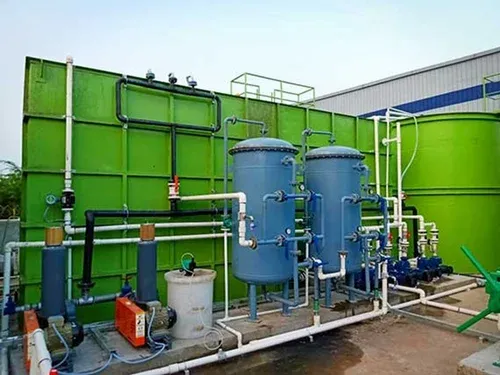What is a Sewage Treatment Plant & How Does It Work?
Sewage treatment plants are a critical component of modern infrastructure, ensuring that the water we use in our homes and businesses is returned to the environment in a safe and clean manner. But what exactly is a sewage treatment plant, and how does it work to process waste? In this article, we’ll dive into the essentials of sewage treatment, breaking down the process step by step and explaining its importance to public health and environmental protection.

What is a Sewage Treatment Plant?
Sewage treatment plant processes are designed to remove contaminants from wastewater, primarily from domestic sewage but also industrial and commercial sources and tertiary treatment processes to improve the quality of wastewater for recycling. The goal is to treat the wastewater to a level where it can either be safely discharged into natural bodies of water or even reused in certain applications.
Sewage treatment involves a combination of physical, chemical, and biological processes to break down harmful pollutants and ensure that the water is returned to the environment in a non-polluting form.
The Importance of Sewage Treatment
Essentially, a sewage treatment plant operates by circulating air to encourage the growth of bacteria to break down sewage. The goal is to deliver much cleaner, more environmentally friendly effluent. It involves a similar process to a typical septic tank but has some key differences. Sewage treatment plants, depending on their size, can treat the waste of commercial properties or a number of domestic dwellings.
Sewage treatment is vital for several reasons:
- Health Protection: Untreated sewage contains harmful bacteria, viruses, and parasites. Proper treatment prevents the spread of diseases.
- Environmental Conservation: By removing harmful pollutants, treated sewage prevents water contamination, preserving ecosystems and marine life.
- Water Recycling: In some advanced treatment plants, the treated water is recycled for non-potable uses, such as irrigation, industrial processes, or even as a source for drinking water after further treatment.
How Does a Sewage Treatment Plant Work?
The treatment process can vary depending on the size of the plant, the type of wastewater, and the specific needs of the community or industry. However, the basic principles are similar across most systems. Let’s break down the primary stages of sewage treatment:
1. Preliminary Treatment (Screening)
The first stage of treatment involves screening the sewage to remove large debris, such as sticks, plastic, and other solid waste that can damage equipment or hinder the treatment process. This step helps protect pumps, pipes, and other machinery.
2. Primary Treatment (Sedimentation)
After the larger materials are removed, the water enters a large sedimentation tank, where it slows down to allow solid waste (sludge) to settle at the bottom. During this stage, grease and oils float to the surface and are skimmed off. The settled sludge is removed and sent for further processing, while the partially treated water moves to the next stage.
3. Secondary Treatment (Biological Treatment)
In secondary treatment, the focus shifts to breaking down organic matter, such as food waste, human waste, and other biodegradable materials. This is typically achieved through biological processes, using bacteria and other microorganisms to consume and digest the organic matter.
There are two main methods of secondary treatment:
- Aerobic Treatment: Involves introducing oxygen into the wastewater, which helps aerobic bacteria break down the organic pollutants.
- Anaerobic Treatment: Uses bacteria that thrive in oxygen-free environments to digest organic materials.
The treated water that emerges from this stage is much cleaner, though still contains some dissolved and suspended solids.
4. Tertiary Treatment (Advanced Treatment)
Some treatment plants employ tertiary treatment, which is an additional step to further purify the water. This can involve processes such as:
- Filtration: Removing remaining solids and particles.
- Chemical Disinfection: Often using chlorine or ultraviolet (UV) light to kill harmful pathogens.
- Nutrient Removal: Removing excess nitrogen and phosphorus that could contribute to water pollution and algal blooms.
Tertiary treatment is often used when the water is to be released into sensitive environments or for reuse purposes.
5. Sludge Treatment and Disposal
The sludge that accumulates during primary and secondary treatment must also be treated before disposal. This typically involves:
- Thickening: Removing excess water to reduce volume.
- Digestion: Using bacteria to break down the organic material in the sludge, which reduces its volume and pathogenic content.
- Dewatering: Further reducing water content, often through mechanical presses or drying beds.
- Disposal: The final sludge can be disposed of in landfills, used as fertilizer, or even converted into biogas for energy production.
Conclusion:
Sewage treatment plants play an essential role in safeguarding public health and protecting the environment by treating and managing wastewater. From screening out large debris to using advanced biological and chemical processes, these facilities ensure that wastewater is cleaned to an acceptable standard before being returned to nature or recycled for other uses. Today’s sewage treatment plants are highly automated, improving plant performance and reducing the risk of human error. Sensor technology, networks and automatic controls keep plants ticking without human intervention. Without sewage treatment, pollution would increase, ecosystems would be damaged, and public health would be at risk. Sewage treatment plants treat sewage from public sewers, producing clean, odourless water we can drink and use to bathe. All the water we consume from the tap is recycled, with drinkable water undergoing tertiary treatment stages.
